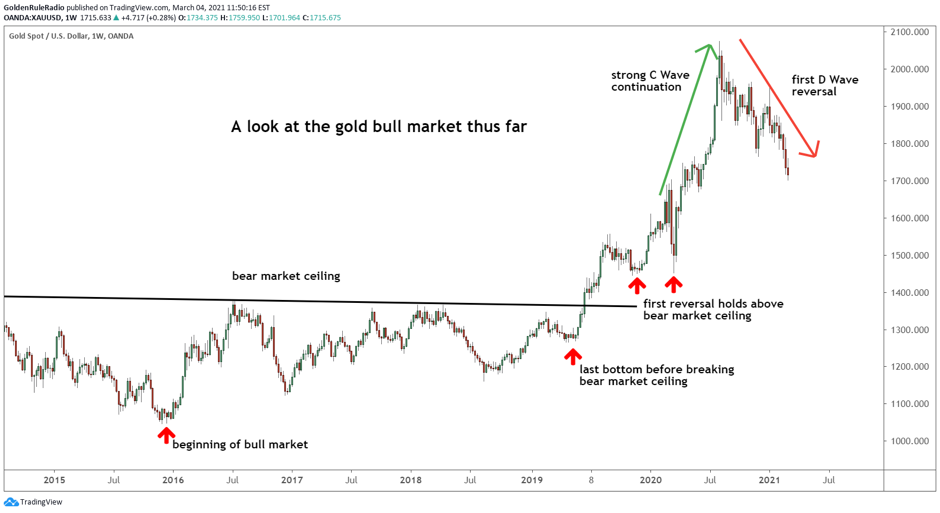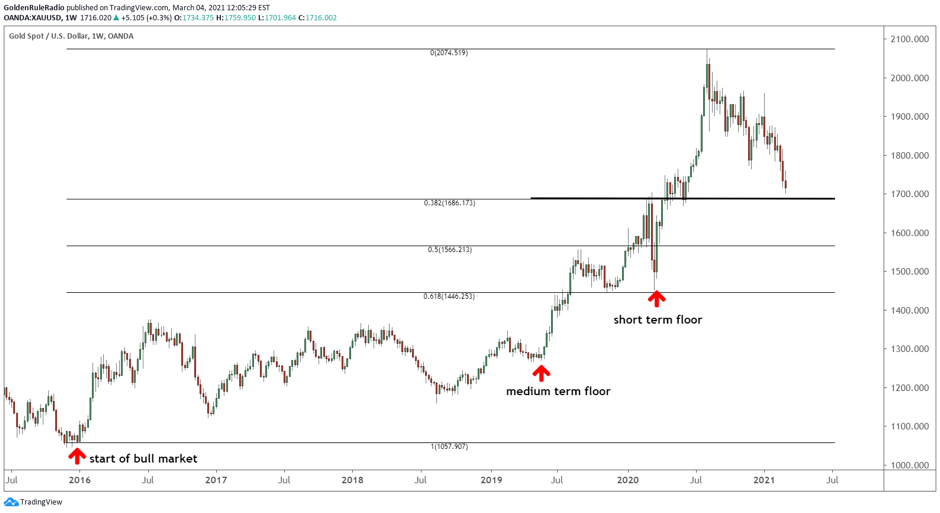In an irrational economy, emotions rule. What does this mean for the long-term performance of gold?
Key Takeaways:
- Gold is likely headed to $1,690, which is the most shallow correction level based on Fibonacci retracement levels dating back to the beginning of gold’s bull market in late 2015. The $1,690 is a key support level because it lined up with both the short-term .618 fib and the long-term .382 fib.
- Gold is dropping for several reasons, including competition with other asset classes (cryptocurrencies and treasuries), a short-term Dollar rally, and artificially subdued inflation expectations by the Fed.
- These short-term bearish trends are providing excellent opportunities to begin entering the gold market through Dollar-cost averaging (VaultPlan). The long-term fundamentals will take over eventually, and gold will start its next leg up.
The widening rift in market sentiment
Stock market bulls say the economy is headed toward a rapid recovery, and record performance in equities over the last year is just the beginning. Stock market bears say we are beelining toward the biggest stock market crash in U.S. history. The scariest part is – both sides have solid evidence to back up their prediction. The ever-widening gap in market sentiment between bears and bulls reflects the painful divide we have seen in American politics in recent years and reminds us that, try as we may, no one can predict the future of financial markets.
When will gold turn around?
Gold is sliding lower and the Dollar is rallying, despite the rapid rise of money in the American economic system. The unstable state of the world economy combined with rapid global money printing should be extremely bullish for gold, but the metal can’t seem to find stable footing after months of price declines. The big question is, where does the decline turn around?
We have been short-term bearish on gold for the last couple months, even though we are in the middle of a massive bull market that kicked off back in late 2015. This bull market has taken gold from $1,050 up to $2,080. The downward trend in the last few months is a healthy technical correction, but that doesn’t stop it from being unpleasant for gold investors.

What price levels should we pay attention to?
As we see from the chart above, gold has been stair-stepping down since its all-time high back in August. We’ve broken through a couple shallow support levels over the last few months – namely the short-term .382 fib and the short-term 50% line (see chart below). These price levels were $1,835 and $1,765, respectively.
Now gold is approaching a major test: the $1,690 price level. $1,690 is the first real long-term test because it lines up with two very important support and resistance levels: the short-term .618 fib and the long-term .382 fib.
When I say the “short-term fib” levels, I am referring to the Fibonacci retracement levels calculated off gold’s most recent leg up, which lasted from November 2019 to August 2020 and took the price from $1,445 to $2,080. On the chart below, the .618 fib ($1,690) is bolded.

The next chart shows the long-term Fibonacci retracement levels, calculated from the beginning of the bull market. The long-term .382 fib (bolded) also lines up with $1,690. This is why, looking at the bull market as a whole, $1,690 is the first potential correction point you would expect to see in the middle of a bull market.
There is no guarantee that gold will find a floor at the long-term .382 fib. The .382 fib is the most shallow technical support level, meaning there are other fib levels below the long-term .382 fib that gold could meet. These lower levels might provide even stronger support for the gold price and finally ending the short-term bearish trend.
Gold will likely hit the key level of $1,690 in the next week, and its price movement from there will give us a better idea of gold’s trajectory for 2021.

Why is gold dropping?
Technical analysis can estimate where the gold price will meet resistance and support. We can guess where the steps in the staircase are, but we do not know when the staircase will turn around. We can talk about price levels all we want, but the real question is: why is gold dropping?
The U.S. economy is under extreme inflationary pressure, which should cause the Dollar to drop and gold to rise. The problem is, short-term price movement often runs contrary to long-term trends. That is the nature of financial markets.
Here are a few other factors pushing gold down:
- Competition with other asset classes
- The short-term Dollar rally
- Artificially subdued inflation expectations by the Fed Fortunately for gold bugs, these factors can only last for so long.
Competition with other asset classes
The 10-year treasury interest rate has doubled since gold’s peak in August, which points to rising inflation expectations. This will ultimately be good for gold, but the trend of rising yields is actually short-term bearish for gold. When interest rates rise, bonds have a higher yield, which makes them more attractive to investors. Treasuries could be pulling the attention from gold as the leading safe-haven asset. The Fed has been very clear about keeping the Fed policy rate low, although interest rates are still rising. This pattern is concerning for equities, because rising interest rates cause the cost of borrowing money to increase, thus crimping economic growth.
The mainstream narrative is taking advantage of gold’s recent weakness and pitting the metal against other asset classes such as cryptocurrencies. Gold is losing the battle for portfolio allocation, primarily because the 2020 financial markets abandoned traditional measures of value for pure emotional momentum.
Gold is not a speculative vehicle, it is a store of wealth. Gold has gone through dozens of correction phases over the last 50 years, and people have announced that gold is dead every single time. And yet, it always ends up re-entering the spotlight as the best investment vehicle for superior returns, hedging against the market, and maintaining purchasing power. The strategic role of precious metals cannot be replaced by any other asset.
Even Bitcoin, which rivals some of gold’s revered characteristics such as liquidity and scarcity, plays a very different role in an investment portfolio. Gold stands above Bitcoin in terms of inherent value, wealth preservation, long-term returns, tangibility, industrial application, and performance during market downturns.
The Dollar is moving…up?
The recent pop in the U.S. Dollar Index is quite surprising considering the last year’s massive fiscal stimulus measures. The Dollar has rallied almost 2% against other currencies in the last 2 months. From a charting perspective, we would expect to see the Dollar Index continue to rally, even approaching 94 or 96 on the chart below.
This rally casts a troubling shadow over the global economic recovery from COVID-19. The recovery has been sporadic and complicated, evidenced by the fact that the Dollar is flying in the face of all logic. Emerging markets, which rely heavily on Dollar funding, could suffer if the Dollar continues to climb. A stronger dollar and higher U.S. yields typically result in tighter financial conditions in emerging markets.

How should I enter the gold market?
Dollar-cost averaging is a fantastic way to take advantage of gold’s lower prices while reducing the impact of volatility. Dollar-cost averaging involves dividing your total investment amount across periodic purchases. A Vaulted feature called VaultPlan allows investors to invest specified amounts of capital at regular intervals, so you do not have to guess where the price is moving. DCA works because the price of gold always rises over time.
It is easy to get discouraged by short-term bearish movement, but we have to remember that emotions are an investor’s greatest enemy. This is the perfect time to start purchasing gold, and Vaulted helps you leverage the best tools and resources in the industry. The best way to enter the gold market is to find a few price levels that make the most sense from a technical standpoint (that’s why this blog exists!) and spread your purchases over those price levels.
The financial world is in a strange place. Fortunately, retail investors have the tools to prepare for uncertainty. More than ever before, individuals can empower their own financial wellbeing by strategically diversifying their portfolios, gaining access to top-tier educational resources, and leveraging investment technology that is built for the consumer.
Vaulted is guided by those principles and has now helped thousands of investors gain access to the world’s most reliable investment vehicle – gold. With the most affordable cost structure in the industry, a simple web-based user interface, and precious metals advisors just a phone call away, Vaulted is absolutely the best way to purchase physical gold.











